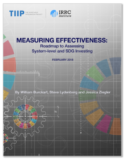A new report provides investors with a breakthrough roadmap for measuring the effectiveness of system-level investing strategies, including measuring progress toward achieving the United Nations’ Sustainable Development Goals (SDGs).
The new report, Measuring Effectiveness: Roadmap to Assessing System-level and SDG Investing, examines how investors can chart a course to assess system-level issues (like those contained in the SDGs) appropriate for their specific situation, and then establish effective goals for influence against which to measure progress. In doing so, investors also can assess the potential usefulness of the tools available to them and the effectiveness of the tools they have selected. Ultimately, this approach enables investors to assess their influence in determining changes at the system-level itself and the potential contribution of their efforts and investments.
The report is authored by William Burckart, Steve Lydenberg and Jessica Ziegler of The Investment Integration Project (TIIP) and was sponsored by the Investor Responsibility Research Center Institute (IRRCi).
A companion document to the report, Measuring Effectiveness: Roadmap to Assessing System-level and SDG Investing—Supplemental Appendices, contains a series of appendices that provide tools and examples for investors, as well as additional context for and information about the concepts discussed.
“Investors increasingly realize that mitigating systemic risk is far more important to their returns over time than any trading strategy,” explained Jon Lukomnik, IRRCi executive director. “That is one reason for the groundswell in investor interest in the sustainable development goals. This report suggests how to go beyond aligning investment strategy with the SDGs and how to actually measure an investor’s ability to impact systemic risk issues.”
“Central to the findings of this report is that investors now can measure whether individual organizations are using system-level investing strategies in ways that can lead to collaborative action and influence,” said report co-author William Burckart. “Ultimately, it is through the collective actions of a diverse set of members of the investment community using a variety of tools in differing ways that sufficient leverage can be achieved to exercise influence within today’s complex, global, interconnected systems.”
“Measuring the effectiveness of system-level investing is possible; it is the foundation upon which investors can base consistent, system-wide impact over time and protect the ability of their funds to generate returns in the long term. To paraphrase the business management pioneer Peter Drucker, the only way investors will be able to effectively manage the wealth-creating potential of these systems is if they measure their influence on them,” Burckart observed.
To help facilitate investors’ use of the roadmap, the report uses an example of climate change, and outlines how investors or third-party evaluators can use the guidance to assess the effectiveness of actions targeted at addressing that key system-level challenge.
Among the key findings in the report is the identification of four foundational characteristics of environmental, societal and financial systems. Investor actions which strengthen any of those four characteristics mitigates systemic risk, while investor actions which weaken any of those four will increase systemic risks.
- Adaptability: the environment, society, or the financial system’s ability to adjust to shocks and major disruptions (i.e., high adaptability, or self-regulation, helps systems better adjust to unanticipated external shocks).
- Clarity: the coherence, flow, access to, and transparency of information about and within a system (i.e., information flows among actors and about system components—and their interrelationships— enables investors’ ability to understand their influence and act accordingly).
- Connectivity: the value of a good or service is determined in part by how many people use it. The more it is used, the greater the benefit to the system (i.e., systems so structured have positive feedback loops that increase their health and resilience).
- Directionality: market incentives structured to encourage positive changes in stakeholder behavior (i.e., healthy systems are those in which influential actors enhance positive characteristics and align their actions with the systems’ fundamental goals).
Watch a video of pre-release event hosted by Morningstar regarding the report here and read an overview of the key findings by Prof. Bob Eccles in Forbes here.
The Investor Responsibility Research Center Institute is a nonprofit research organization that funds academic and practitioner research enabling investors, policymakers, and other stakeholders to make data-driven decisions. IRRCi research covers a wide range of topics of interest to investors, is objective, unbiased, and disseminated widely. More information is available at https://irrcinstitute.org
The Investment Integration Project helps institutional investors understand the feedback loops between their investments and the planet’s overarching systems – be they environmental, societal or financial – that make profitable investment opportunities possible. Once this relationship is understood, TIIP provides investors with the tools to help manage the impacts of their investment policies and practices on these systems. More information is available at http://tiiproject.com




